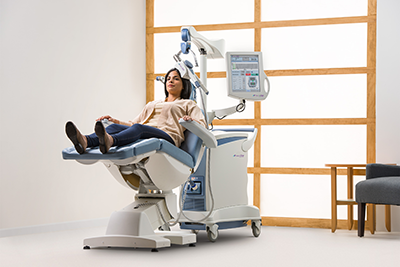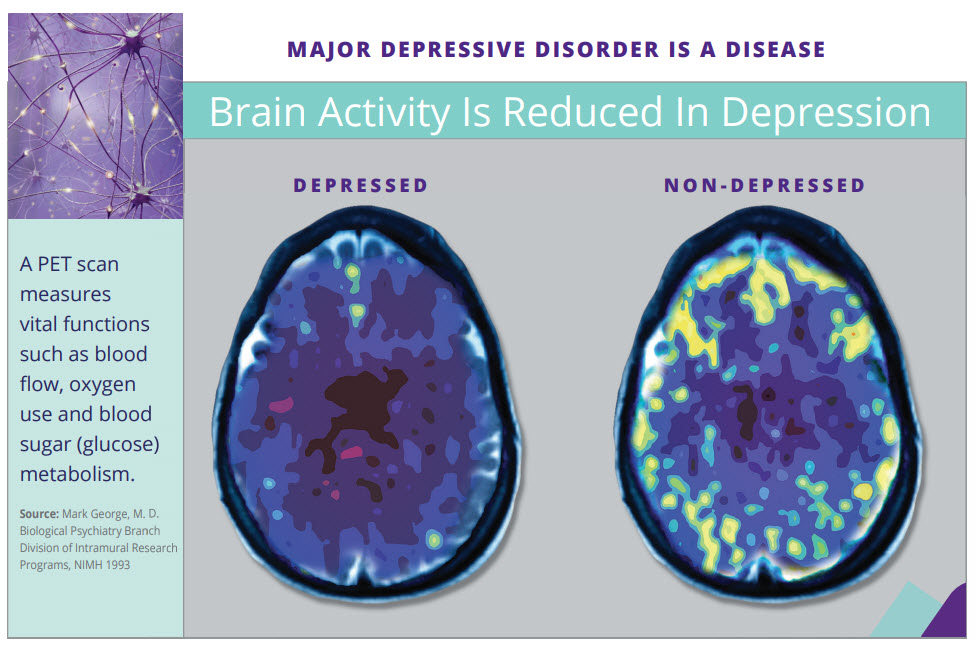TMS Therapy for Depression
What is TMS Therapy?
TMS stands for transcranial magnetic stimulation. It is a non-surgical procedure used to treat depression by stimulating the brain using electromagnetic fields, similar to those produced by an MRI machine. During TMS Therapy, a magnetic field is administered in very short pulses to the part of the brain that is associated with depression. These pulses of magnetic energy are the same type and strength as those produced by an MRI.
TMS Therapy uses short pulses of electric current to stimulate the brain cells in the area of the brain that is thought to function abnormally in patients with depression. These electrical currents activate cells within the brain which are thought to release neurotransmitters like serotonin, norepinephrine, and dopamine. Since depression is thought to be the result of an imbalance of these chemicals in the brain, TMS can restore that balance and, thus, relieve depression.
Is Transcranial Magnetic Stimulation Right For Your Depression?
If you agree with two or more of these statements, contact us to learn more about TMS Therapy:
- RDepression symptoms have interfered with my daily life.
- RI am not satisfied with the results I get from depression medication.
- RI have had, or have worried about, side effects from depression medications.
- RI have switched medications for depression due to side effects.
- RI am interested in a proven, non-drug therapy for depression.
Real People, Real Stories.
Many people who suffer from depression have stories like yours.
How Does It Work?
Transcranial magnetic stimulation (TMS) uses a targeted pulsed magnetic field, similar to what is used in an MRI (magnetic resonance imaging) machine. While the client is awake and alert, NeuroStar Advanced TMS Therapy stimulates areas of the brain that are underactive in depression.
Before Treatment Begins

- You’ll recline comfortably in the treatment chair
- A small, curved magnetic coil will be positioned lightly on your head
Treatment

- NeuroStar delivers focused magnetic stimulation directly to the target areas of the brain
- You’ll hear a clicking sound and feel a tapping sensation on your head
After Treatment

- You can resume normal activities immediately
- Because there are no effects on alertness or memory, you can drive yourself to and from treatment sessions
Answers to Common Questions About TMS
Does TMS hurt?
- The most commonly reported symptom is some sensitivity at the site where the magnetic pulse is directed. Many patients describe the feeling of TMS as a light tapping or ‘tingly’ sensation on their forehead.
- The most common side effect of TMS is a temporary mild headache during or shortly after the TMS session. Most patients who experience headaches report that they only happen in the first week or two of treatment. Other symptoms include mild facial twitching during treatment or a slight tingling sensation on the forehead or scalp at the site of the stimulation.
Is TMS like ‘Shock Therapy’?
- Yes and No. Although TMS and Electroconvulsive Therapy (aka ECT or ‘Shock Therapy’) both work to stimulate the brain; ECT must be administered in a hospital setting, and you must be sedated (put to sleep) in order to tolerate the treatment. In ECT, electric currents are delivered to the brain in way that causes small seizures. The most commonly reported side effects of ECT treatment are nausea, headache, jaw pain, muscle aches, confusion, or even memory loss of events that occurred in the weeks before or after treatment.
- With TMS, the treatments are given in an outpatient/office setting, while you are awake. During TMS sessions, patients are encouraged to read, watch videos, play a game on their phone, or participate in any other activity that they can while sitting upright in the TMS chair. It is important to take in positive stimuli while the treatment is in progress.
Is TMS safe?
- The FDA approved the use of TMS for the treatment of depression in 2008. Since then, multiple clinical trials have been done on tens-of-thousands of patients. The results of these studies have proven that TMS Therapy is a safe and effective alternative in treating patients who have not experienced adequate relief from their depression symptoms with medications.
How much does TMS cost?
- Most health insurance companies cover TMS Therapy, but the amount of coverage for the treatment can vary for each insurance provider. Some will cover it 100%, while others will only cover a portion of the cost. The out-of-pocket cost for you may differ based on your plan benefits, co-pays, or deductibles. With your consent, we can do a benefit investigation prior to determine exactly what your out-of-pocket cost would be. We can also work with you on payment options as needed.
Do I stop taking my medications when I go through TMS Therapy?
- Do not stop taking your medications prior to TMS Therapy. Throughout the course of your therapy, we will work with your Primary Care Physician or Health Care Provider to manage your medications. Some people continue to take some or all of their antidepressant medications throughout the entire course of treatment. Based on your response, your doctor may begin tapering off some of your medications during or after TMS therapy.
How long does a TMS course of therapy take?
- The typical initial course of treatment consists of 30-36 sessions. One treatment session takes about 20-30 minutes. A standard TMS Therapy schedule is one session per day, 4 or 5 days a week for 6 weeks. After the initial phase, the therapy is tapered off over the course of 3 weeks with 2-3 sessions [days] per week. The total ‘treatment period’ is between 2-3 months, depending on how it is scheduled.
What if I can’t come every day or if I miss days?
- For optimal results, we recommend following the standard treatment schedule, BUT we understand that things come up in life. If you have to miss an appointment, we will work with you to reschedule your session. If a major life event occurs, and you have to miss multiple sessions, we will provide counsel on your options for resuming therapy so that you can have the best possible outcome.
How long does it take for TMS to work?
- The response to treatment varies based on the individual. Many patients start to feel the positive effects of TMS therapy after the first week, but on average, patients reported a “Noticeable Difference” in their general mood sometime between 2-4 weeks of therapy. Many patients reported that their depression symptoms continued to improve even after their course of therapy was complete.
How long do the effects of TMS last?
- The lasting effect of TMS varies by patient; however, multiple clinical trials [studies] have shown that after one year nearly 70% of patients maintained their level of response (which means they felt the same way as they did after completing their course of treatment); and 45% of patients achieved ‘remission’ (meaning they found relief from or were free of depressive symptoms). In some cases (maybe due to age, life changes, severity of depression, or environmental factors), patients may need to return at some point for an additional course of TMS Therapy, called ‘maintenance therapy’. In clinical studies only 1 in 3 patients needed to return for maintenance therapy sessions.
Additional Resources
For people with Major Depressive Disorder (MDD), long-term remission becomes less likely with each prescription medication treatment attempt. As antidepressant medication increases, so can side effects and the potential for treatment failure. NeuroStar Advanced Therapy is the TMS provider we use at OHM. TMS can help people who struggle with MDD even after taking antidepressant medication. It helps activate the natural function of the brain’s neurotransmitters using a non-invasive magnetic field.
You can find a lot of information about NeuroStar and TMS in general on the NeuroStar website: neurostar.com
Downloads





